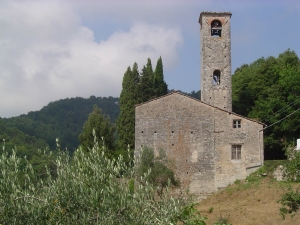
Information
Foundation:
XII secolo
District/Location:
Camaiore, località Albiano
District:
Versilia


In the small village of Albiano, built around a destroyed castle, the church of Saint Mary still shows, especially in its beautiful bell tower, obvious signs of its ancient origin.
Santa Maria, Albiano
The town of Albiano has been documented since the 10th century, while the construction of the castle, wanted by the Lucchesi to better exercise control over the ever-turbulent lands of Versilia, should be referable to the end of the 12th century. In order to establish instead constructive stages and phases of the church of Santa Maria, we are not helped by documents (the church is simply mentioned in the Rationes Decimarum - the register of tithes that each religious body of the diocese should have paid - of 1260 as dependent on the parish of Monsagrati) and we must turn to the detailed analysis of the architectural parts and construction techniques. In this way it is possible to establish that the most ancient parts of a building evidently much altered are those of the south side and of the lower part of the bell tower, realized in rows of limestone drafts. In the bell tower there is also an architectural decoration with blind arches, together with a small cross always made with the same limestone drafts. In the late medieval period the church underwent a substantial reconstruction intervention which involved the apse, north side and façade: certainly at this stage an apse was no longer present (the church has a single nave with straight termination) but it is impossible to establish whether whether or not it was present in the previous building. The façade portal and the single lancet windows on the side date back to this date. The documents of the beginning of the 14th century testify to the presence of a small pilgrim hospital adjacent to the church, which evidently enjoyed a particular centrality at the time: it is possible that the construction phase described above dates back to these years. In the 18th century then the large windows on the south side opened up and a lateral portal replaced the medieval ones, buffered as well as the single-light windows; the upper part of the bell tower was also built on this occasion. Inside the church there is a 15th century wooden Sant’Antonio Abate, while the beautiful canvas with the Madonna and Saints by Pietro Paolini was transferred to the Museum of Sacred Art of Camaiore.
Scopri altre attrazioni vicino a Saint Mary
See allYou may also like..
See allFind more
0











